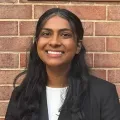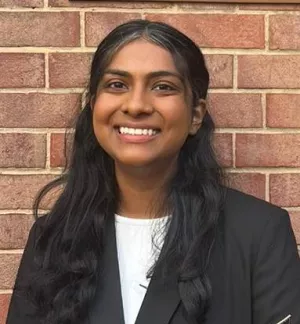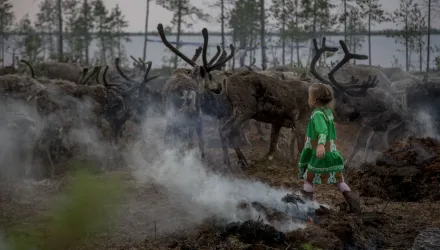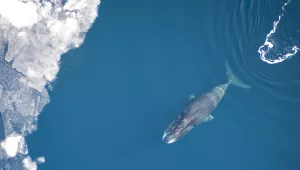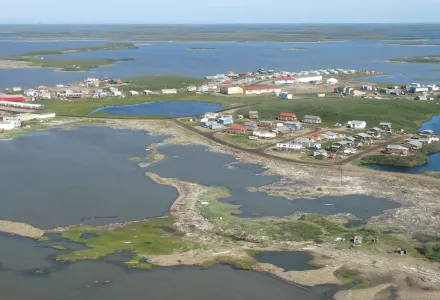
Introduction
There is a growing recognition that permafrost thaw significantly impacts the way of life for communities across the Arctic. Numerous projects aim to expand our understanding of permafrost dynamics, emphasizing the need for collaboration with the communities most impacted by these changes. These initiatives focus on delivering relevant knowledge and data to empower local decision-making.
To advance this work, Permafrost Pathways and the Arctic Athabaskan Council co-hosted a day-long workshop prior to the 12th International Conference on Permafrost (ICOP) in Whitehorse, Canada. The workshop brought together 27 participants, including 22 ICOP attendees with experience working alongside communities and five representatives from nearby Indigenous communities impacted by permafrost thaw. This group was dedicated to building bridges, addressing knowledge gaps, and developing solutions to turn insights into action, with community representatives sharing firsthand experiences that deepened the conversation.
The workshop focused on identifying practical approaches to building permafrost knowledge and leveraging research to enhance community resilience. Conversations underscored the importance of developing continuous knowledge exchange between researchers, communities, and across initiatives as an avenue for developing informed and actionable solutions.
The workshop featured three sharing circles, where participants exchanged insights and observations from their personal and professional experiences.
These sharing circles focused on the following components:
- Building Permafrost Knowledge: Approaches for building permafrost knowledge – what knowledge, why, and who is involved?
- Translating Permafrost Knowledge into Action: How do we translate knowledge into action? How do we leverage research to contribute to community resilience? Who needs to be at the table, why, and when?
- Catalyzing Systemic Change: Moving from one project’s success to systemic change – learning from good practices to advance decision-making and institutional change.
This report highlights the key points raised during the discussions. While not comprehensive, it aims to reflect the core insights shared by participants.
Impacts on the Communities
Participants shared insights into the environmental changes affecting their communities. Key observations included several areas of impact.
Key Takeaways
1. Create Collaborative Feedback Loops
Communities and researchers should be in continuous conversation at each step of the research process, exchanging ideas, feedback, and knowledge starting well before research questions are even determined to after the evaluation of findings. Ensuring dialogue at each research benchmark helps ground research in community needs, builds both community and researcher capacity, and facilitates the translation of findings into action. Participants shared the following regarding each step of the research process:
- Problem Identification: By focusing research on the questions that communities want answered, rather than the interests of researchers and funders, findings can more effectively address the problems communities are experiencing as a result of permafrost thaw. Some participants described a “client” or “service” model for partnership, where communities approached researchers with concerns related to local road degradation or water quality, and researchers conducted assessments to address these specific concerns. Collaborative development of research questions can help shift traditional power dynamics and set expectations for productive relationships for the length of the partnership.
- Process Development: Researchers can work with communities to co-create process guides that outline estimated timelines, benchmarks, and areas where community knowledge is needed. Incorporating regular meetings between researchers, community stakeholders, and working groups is crucial for providing updates on the status of the project, communicating preliminary findings, and addressing questions or concerns that arise. By developing this framework together, communities can have greater transparency into the research process unfolding in their community and have an early opportunity to identify practical and strategic flaws or make referrals to additional stakeholders for consultation. Workshop participants indicated that their research projects were more successful when they focused on the research interests of communities when developing processes, contextualizing where individual steps fit into the “bigger picture.” One suggested model for reference was the Nexus Environmental Assessment Tool (NEAT+), which can be used to determine who should be a part of a decision-making process.
- Data Collection: Researchers can engage in collaborative data collection by documenting local and Indigenous knowledge for community records and training communities to use testing equipment, GIS, and drone technology. Building this local capacity through requested training opportunities can help communities continue research independently both during and after the formal research partnership. One participant shared the value of training community members to use Google Timelapse, a photo archive that was a useful reference for a community experiencing landscape changes overtime. Researchers similarly shared the incredible value of partnering with those who have a deep knowledge of the land and how it has been changing over time and are already working in or monitoring areas where research is underway. Participants shared stories of co-creating maps using local knowledge and discussing permafrost cores samples in community workshops.
- Communicating Findings: While the practice of sharing results and findings of research with communities has become standard and increasingly required, participants shared that there are still gaps in making results truly accessible to communities. In addition to technical restrictions such as paywalls and internet access, reports may be written for academic or scientific audiences rather than in more “digestible” language. When framing these findings, one participant emphasized that researchers are not there to make decisions, but rather to provide information that helps communities make informed decisions. Participants recommended hosting a public meeting/workshop or presenting at a Tribal Council to personally share findings and create opportunities for discussion and asking questions. A suggested model for data accessibility was the FAIR (Findability, Accessibility, Interoperability, and Reuse) model that establishes principles around community-oriented data collection and dissemination. Researchers should make particular efforts to urgently and clearly disseminate information related to health and safety, such as maps outlining potential hazards.
Kaska Chief Dylan Loblaw shared that in traditional knowledge, there is a cycle, not an end. Engaging the community in every step of the research process, from data collection to dissemination, fosters trust and ensures that the findings are relevant and beneficial to those directly affected by environmental changes. By incorporating collaborative practices at each step, research can become intertwined with communities, pushing research into a continuous, cyclical practice of questioning, discovery, and problem-solving.
2. Resource and Respect Communities
Researchers must ensure that communities collaborating on research initiatives are adequately resourced and their privacy, sovereignty, and capacity are respected.
- Compensation and Capacity in Community Research: Research engagements often span multiple years, placing ongoing demands on the time, knowledge, and attention of local and Indigenous communities. Unlike academics and scientists, who are compensated for their expertise, community members contributing essential insights are frequently unpaid despite significant hours dedicated to the research process. Workshop participants emphasized the need to financially compensate communities for “knowledge exports” and to offer technical support for grant writing, enabling communities and local organizations to apply for their own funding. This issue goes beyond compensation; there is a critical need to address capacity within communities to engage effectively in research and to access funding. Limited knowledge of funding opportunities and unequal access to resources can further disadvantage these communities, highlighting the importance of building equitable research partnerships that prioritize both compensation and capacity-building.
- Use of Time and Land: Participants also shared the importance of not overwhelming the capacity of participating communities. Smaller or under-resourced communities and community-based organizations may have few volunteers or staff available to dedicate to research initiatives. One participant shared the story of there being so many researchers on the land day after day for months on end that it disrupted communities’ ability to use the land. Researchers can coordinate across research initiatives to streamline asks of communities to leverage community time and physical space more strategically. Extending outreach requests to various community members rather than repeated requests to the same “unicorn” individual can reduce strain on participants and decentralize awareness and engagement around the project. Another recommendation was to carefully consider the benefits of the research to the community participating in the research project relative to the potential burden the project may impose.
- Data Ownership: In addition to protecting community time and capacity, participants discussed sensitivities around protecting community data and Indigenous knowledge. One participant shared the story of a researcher documenting knowledge from an elder, only to have that information eventually circulated to territorial authorities who used that information against the community. Researchers must create greater protections and models of consent around when and how information is disseminated outside of a community. Workshop participants discussed the potential role of intellectual property rights and independent research licensing. One suggested methodology was the Ownership, Control, Access, Possession Model (OCAP), where collected data is owned by the community.
- Building Power: Finally, participants discussed elements of power around receiving funding from national and territorial governments, including perceptions that decision-makers may have more short-term priorities that diverge from community concerns. Participants shared an interest in using research to shift this power dynamic by getting results and findings in front of decision-makers who can make larger-scale policy change.
3. Build Bridges Across Initiatives
Communities and governments across Canada have piloted successful community-research collaborative initiatives that may form the basis for more strategic and systematic best practice sharing. Some programs highlighted during the discussion include:
- Imaryuk Monitors: The Imaryuk Community Monitoring Program in the Imaryuk (Husky Lakes) region began as part of the Canadian government’s Guardian Program. Community members formed the Imaryuk Monitors to monitor and report changes to the region’s Inuvik-Tuktoyaktuk Highway (ITH), which was built on permafrost.
- Leaders in Permafrost (LEAP): Funded by the Collaborative Research and Training Experience (CREATE) program of the Natural Sciences and Engineering Research Council of Canada (NSERC), LEAP trains graduate students and some community members for careers in researching and developing solutions to permafrost thaw.
- Cumulative Impact Monitoring Program (NWT CIMP): Funded by the government of the Northwest Territories, this program partners with communities to identify local priorities for monitoring and research and then provides funding and training for community members to collaborate in monitoring efforts.
As just these handful of programs demonstrate, collaborative initiatives across the North span a broad diversity of objectives, geographies, funding mechanisms, and governance structures. Creating greater connection and communication between these initiatives can help communities and practitioners share best practices across silos and transfer innovations across programmatic differences.
Looking Ahead
Indigenous communities have been adapting to changing environmental conditions for generations. The most effective projects collaborate closely with community members to understand the land’s history and address the community’s needs and concerns. The complex colonial history, combined with the influx of researchers working in Northern communities, has left an exploitative legacy, fostering a deep wariness towards outside intervention. Relationship building is essential for establishing trust and mutual respect.
This workshop provided an important opportunity for dialogue. The insights shared here can not only serve as a resource of permafrost researchers, but it will inform future discussions and activities focused on:
- Building permafrost knowledge that meets the needs and interests of communities;
- Supporting communities to translate permafrost knowledge into concrete actions; and
- Move beyond advancing the success of individual projects to catalyzing systemic changes to meet the needs of the many Arctic and Northern communities facing the impacts of permafrost thaw.
As a next step, the Arctic Athabaskan Council and Permafrost Pathways will draw from and build on this workshop by hosting a second workshop in 2025 focused on bringing together representatives of Northern Indigenous communities that are impacted by permafrost thaw.
Participant List
| First Name | Last Name | Organization |
|---|---|---|
| Liane | Benoit | Arctic Athabaskan Council |
| Fabrice | Calmels | Yukon University |
| Elise | Devoie | Wilfrid Laurier |
| Cindy | Dickson | Arctic Athabaskan Council |
| Hammond | Dick | Ross River Dena Council |
| Bill | Erasmus | Arctic Athabaskan Council |
| Susanna | Gartler | University of Vienna, Austrian Polar Research Institute |
| Chris | Gruben | Inuvialuit Land Administration |
| Jennifer | Humphries | Aurora Research Institute |
| Kumari | Karunaratne | Northwest Territories Geological Survey |
| Janet | King | PermafrostNet |
| Steve | Kokelj | Northewest Territories Geological Survey |
| Michelle | Landry | University of Alberta |
| Cyrielle | Laurent | Yukon University |
| Emmanuel | L'Hérault | Université Laval, Center for Northern Studies |
| Dylan | Loblaw | Ross River Dena Council |
| Tristan | MacLean | PermafrostNet |
| Margret | Njootli | Vuntut Gwitchin First Nation |
| Pascale | Roy-Leveillee | Université Laval |
| Alexa | Scully | K'ahsho Got'ine Foundation |
| Jennifer | Spence | Permafrost Pathways, Harvard Kennedy School |
| Arianne B. | St-Amour | Cryo-UL Lab, Université Laval, Center for Northern Studies |
| Emma | Street | University of Victoria |
| Tessa | Varvares | Permafrost Pathways, Harvard Kennedy School |
| Alice | Wilson | Northwest Territories Geological Survey |
| Jackie | Ziegler | University of Victoria |
Varvares, Tessa and Aruni Ranaweera. “Call to Action on Permafrost: Applying Knowledge and Research to Complex Problems Facing Communities.” Belfer Center for Science and International Affairs, Harvard Kennedy School, December 16, 2024


